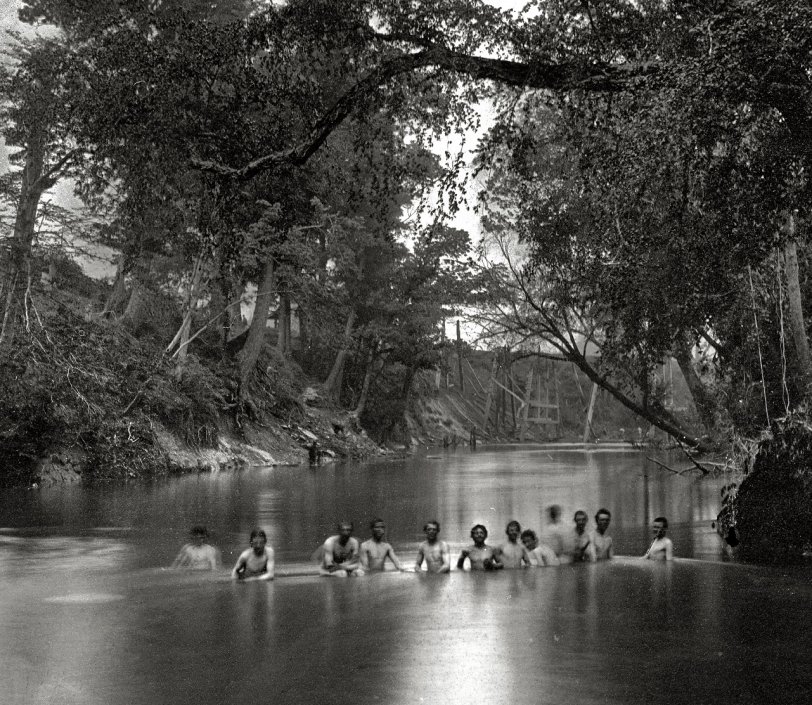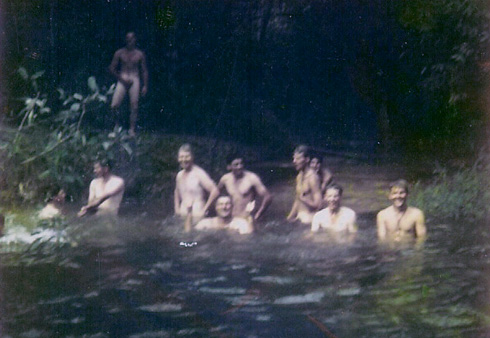


Framed or unframed, desk size to sofa size, printed by us in Arizona and Alabama since 2007. Explore now.
Shorpy is funded by you. Patreon contributors get an ad-free experience.
Learn more.

- Icing Platform?
- Indiana Harbor Belt abides
- Freezing haze
- Corrections (for those who care)
- C&NW at Nelson
- Fallen Flags
- A dangerous job made worse
- Water Stop
- Passenger trains have right of way over freights?
- Coal
- Never ceases to amaze me.
- Still chuggin' (in model form)
- Great shot
- Westerly Breeze
- For the men, a trapeze
- Tickled
- Sense of loneliness ...
- 2 cents
- Charm City
- What an Outrage
- Brighton Park
- Catenary Supports
- Just a Little Before I was Born
- Afternoon normal
- The Flat Iron Cafe survives
- Aging in Place
- Raise your hand
- Good and Bad
- Oh, the 70's
- Nooooooi
Print Emporium
The River: 1864

May 1864. North Anna River, Virginia. "Soldiers bathing. Ruins of Richmond & Fredericksburg railroad bridge in the distance." Wet plate glass negative, left half of stereo pair, by Timothy H. O'Sullivan. Library of Congress. View full size.
The River: 1969 (105 years later)
February 1969. Stream somewhere north of Saigon, South Vietnam. Soldiers bathing, jungle all around. Scanned Polaroid print.
"Our platoon, from the 1st Infantry Division, had been out on a hot, dirty patrol/ambush mission for about a week. We came upon this incredibly clear cool stream, and somebody had an idea...we posted a couple of sentries, got out the soap and had ourselves one hell of a (quiet) skinny-dip. I am the dipper on the far right. I don't think we had permission to do this, but then I don't think we asked, either(!)"
The similarity between the two photos continues to amaze me.
Thank you Shorpy/Dave, for allowing me to share one of the few happy memories of that year in Vietnam.

Blue and Gray and Red
Yes, as a reenactor (with my 30lbs) after a weekend of war without sunscreen I come home with the same tan lines. Face, neck and the back of my hands all end up nice and toasty.
Dirt? Tans?
That is what struck me also when I saw this photograph.
Civil War Rations
Of course the typical Civil War reenactor is about 30 lbs overweight because he hasn't been eating typical Civil War rations. Marching rations for a Union soldier (like these guys most likely are):
1 lb. hard bread
3/4 lb. salt pork or 1 1/4 lb. fresh meat
plus sugar, coffee, and salt (the rations for these were set per 100 men: 15 lbs. sugar, 10 lbs. green coffee or 8 lbs. roasted and ground coffee, 3 pounds 12 ounces salt). Other commodities, like dessicated potatoes and dried vegetables, were added when the army was in camp.
Confederate soldiers were supposedly on the same sort of rations although they obviously didn't get coffee because of the blockade, their fresh meat tended to be pork rather than beef, and their supply services tended to be far less efficient than the Union Army's. By the time of the Siege of Petersburg the Confederates were really suffering.
Skinny Soldiers
It never fails to amuse me to see the typical Civil War reenactor, authentic in every detail except for being 30 pounds overweight.
Tanned & Bland
Up until the 1920s, it was rare for men to be shirtless in public, even in all-male settings like an army. The phrase "half-naked" was used to denote this kind of undress with the connotation that it was shameful. Not until after WW I did men lose their tops when bathing and even that was controversial until Hollywood depicted leading men sans chemise in a variety of settings.
Dirt? Tans?
Their bodies are so pale compared to their faces. I wonder if it is dirt or a tan? Of course in those days, their bodies wouldn't see sunlight very often, so it could be a mix of both.
Anna Get Your Gun
The Battle of North Anna was fought from May 23 to May 26, 1864 - a lead up to the appalling Battle of Cold Harbor.
Another Shorpy here on Cold Harbor.
North Anna
These boys are skinny, aren't they? I've crossed this river a million times. Amazing. I just discovered your blog and I love love love it. Thanks for collecting the photos.
























On Shorpy:
Today’s Top 5